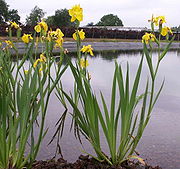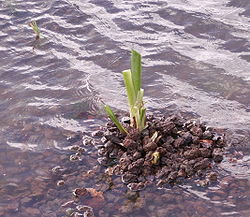
Organisms used in water purification
Encyclopedia

Water purification
Water purification is the process of removing undesirable chemicals, materials, and biological contaminants from contaminated water. The goal is to produce water fit for a specific purpose...
, improving efficiency
Efficiency
Efficiency in general describes the extent to which time or effort is well used for the intended task or purpose. It is often used with the specific purpose of relaying the capability of a specific application of effort to produce a specific outcome effectively with a minimum amount or quantity of...
and/or ecosystem
Ecosystem
An ecosystem is a biological environment consisting of all the organisms living in a particular area, as well as all the nonliving , physical components of the environment with which the organisms interact, such as air, soil, water and sunlight....
support.
Organisms
Plants perform multiple roles in water purification. They provide shadeShade
Shade is the blocking of sunlight by any object, and also the shadow created by that object. Shade also consists of the colors grey, black, white, etc...
, a refuge for fish
Fish
Fish are a paraphyletic group of organisms that consist of all gill-bearing aquatic vertebrate animals that lack limbs with digits. Included in this definition are the living hagfish, lampreys, and cartilaginous and bony fish, as well as various extinct related groups...
, oxygen
Oxygen
Oxygen is the element with atomic number 8 and represented by the symbol O. Its name derives from the Greek roots ὀξύς and -γενής , because at the time of naming, it was mistakenly thought that all acids required oxygen in their composition...
for aerobic bacteria. In addition, fish
Fish
Fish are a paraphyletic group of organisms that consist of all gill-bearing aquatic vertebrate animals that lack limbs with digits. Included in this definition are the living hagfish, lampreys, and cartilaginous and bony fish, as well as various extinct related groups...
can limit pests such as mosquitoes.
The choice of organism
Organism
In biology, an organism is any contiguous living system . In at least some form, all organisms are capable of response to stimuli, reproduction, growth and development, and maintenance of homoeostasis as a stable whole.An organism may either be unicellular or, as in the case of humans, comprise...
depends on the local climate
Climate
Climate encompasses the statistics of temperature, humidity, atmospheric pressure, wind, rainfall, atmospheric particle count and other meteorological elemental measurements in a given region over long periods...
different species
Species
In biology, a species is one of the basic units of biological classification and a taxonomic rank. A species is often defined as a group of organisms capable of interbreeding and producing fertile offspring. While in many cases this definition is adequate, more precise or differing measures are...
and other factors. Indigenous species usually tend to be better adapted to the local environment.
Plants

Species
In biology, a species is one of the basic units of biological classification and a taxonomic rank. A species is often defined as a group of organisms capable of interbreeding and producing fertile offspring. While in many cases this definition is adequate, more precise or differing measures are...
are necessary in each of four depth-zones.
- Greater than 120 centimetres (47.2 in)
Water purifying
Plants purify water by consuming excess nutrients and by de-acidAcid
An acid is a substance which reacts with a base. Commonly, acids can be identified as tasting sour, reacting with metals such as calcium, and bases like sodium carbonate. Aqueous acids have a pH of less than 7, where an acid of lower pH is typically stronger, and turn blue litmus paper red...
ifying it by removing carbon dioxide
Carbon dioxide
Carbon dioxide is a naturally occurring chemical compound composed of two oxygen atoms covalently bonded to a single carbon atom...
.
- Nymphea albaNymphaeaNymphaea is a genus of aquatic plants in the family Nymphaeaceae. There are about 50 species in the genus, which has a cosmopolitan distribution.-Name:The common name, shared with some other genera in the same family, is Water Lily....
; for temperate climates, depth 60-120cm, is one of the best options. - Phragmites australisPhragmitesPhragmites, the Common reed, is a large perennial grass found in wetlands throughout temperate and tropical regions of the world. Phragmites australis is sometimes regarded as the sole species of the genus Phragmites, though some botanists divide Phragmites australis into three or four species...
, for temperate climates, is one of the best options. Now invasive in many areas. - Sparganium erectumSparganiumSparganium is a genus of flowering plants, containing about 20 species in temperate regions of both the Northern and Southern Hemispheres. It was previously placed alone in the family Sparganiaceae...
, for temperate climates, depth 60-120cm, is one of the best options. - Iris pseudacorusIris pseudacorusIris pseudacorus is a species of Iris, native to Europe, western Asia and northwest Africa. Common names include yellow iris and yellow flag...
, for temperate climates, depth 0-20cm, is one of the best options, is invasive. - Schoenoplectus lacustrisSchoenoplectusSchoenoplectus is a genus of about 80 species of sedges with a cosmopolitan distribution. Note that the name bulrush is also applied to species in the unrelated genus Typha...
, for temperate climates. - carex acutiformisCarexCarex is a genus of plants in the family Cyperaceae, commonly known as sedges. Other members of the Cyperaceae family are also called sedges, however those of genus Carex may be called "true" sedges, and it is the most species-rich genus in the family. The study of Carex is known as...
, for temperate climates.
Oxygen-supplying
- Stratiotes aloidesStratiotesStratiotes is a genus of submerged aquatic plant commonly known as water soldiers. A characteristic of the genus is the habit of the plants rising to the surface at flowering time.-Description:...
, for temperate climates, depth 40-60cm, is one of the best options. - Hydrocharis morsus-ranaeHydrocharisHydrocharis is a genus of aquatic plants within the family Hydrocharitaceae.The best known species is Hydrocharis morsus-ranae, commonly called common or European frogbit, and occasionally water-poppy. The name "American frogbit" refers to another aquatic plant, Limnobium spongia....
, temperate climates, depth 40-60cm is one of the best options. Extremely invasive and is listed on the Washington State Noxious Weeds list. - Acorus calamus, for temperate climates
Shade/refuge-supplying
- Hydrocharis morsus-ranaeHydrocharisHydrocharis is a genus of aquatic plants within the family Hydrocharitaceae.The best known species is Hydrocharis morsus-ranae, commonly called common or European frogbit, and occasionally water-poppy. The name "American frogbit" refers to another aquatic plant, Limnobium spongia....
, temperate climates, depth 40-60cm, is one of the best options. - Nuphar luteaNupharNuphar is genus of aquatic plants in the family Nymphaeaceae, with a temperate to subarctic Northern Hemisphere distribution. Common names include water-lily , pond-lily, and spatterdock .A total of eight species and three hybrids are currently accepted in the genus...
, temperate climates, depth 60-120cm, develops floating leaf.
Fish
Different species required for each of 3 depth-zones. The fish need to be herbivores.- Surface
- Middle
- Bottom
Surface
- Leuciscus leuciscus, for temperate climates.
- Leuciscus idus, for temperate climates.
- Scardinius erythrophthalmus, for temperate climates.
Bacteria
Indigenous bacteria are preferred to ensure that good adaptation to local conditions. Bacteria can be grown by submerging strawStraw
Straw is an agricultural by-product, the dry stalks of cereal plants, after the grain and chaff have been removed. Straw makes up about half of the yield of cereal crops such as barley, oats, rice, rye and wheat. It has many uses, including fuel, livestock bedding and fodder, thatching and...
(or other plant material) in water for several days. The bacteria automatically populate the material.
Extra considerations
For ecologic/self-purifying ponds, de-nutrified soil needs to be taken for the plants to prevent the possible growth of algaeAlgae
Algae are a large and diverse group of simple, typically autotrophic organisms, ranging from unicellular to multicellular forms, such as the giant kelps that grow to 65 meters in length. They are photosynthetic like plants, and "simple" because their tissues are not organized into the many...
.
Coconut fibre growing medium is best used to prevent soil from being spread around and to sometimes to let the plants root in.
Example system
The following choices occupy all depth-zone niches and are mutually compatible in the same pond.Plants
- 0-20cm—Iris pseudacorusIris pseudacorusIris pseudacorus is a species of Iris, native to Europe, western Asia and northwest Africa. Common names include yellow iris and yellow flag...
, Sparganium erectumSparganiumSparganium is a genus of flowering plants, containing about 20 species in temperate regions of both the Northern and Southern Hemispheres. It was previously placed alone in the family Sparganiaceae... - 40-60cm—Stratiotes aloidesStratiotesStratiotes is a genus of submerged aquatic plant commonly known as water soldiers. A characteristic of the genus is the habit of the plants rising to the surface at flowering time.-Description:...
, Hydrocharis morsus-ranaeHydrocharisHydrocharis is a genus of aquatic plants within the family Hydrocharitaceae.The best known species is Hydrocharis morsus-ranae, commonly called common or European frogbit, and occasionally water-poppy. The name "American frogbit" refers to another aquatic plant, Limnobium spongia.... - 60-120cm—Nymphea albaNymphaeaNymphaea is a genus of aquatic plants in the family Nymphaeaceae. There are about 50 species in the genus, which has a cosmopolitan distribution.-Name:The common name, shared with some other genera in the same family, is Water Lily....
, Nuphar luteaNupharNuphar is genus of aquatic plants in the family Nymphaeaceae, with a temperate to subarctic Northern Hemisphere distribution. Common names include water-lily , pond-lily, and spatterdock .A total of eight species and three hybrids are currently accepted in the genus... - Deep—Myriophyllum spicatumMyriophyllumMyriophyllum is a genus of about 69 species of freshwater aquatic plants, with a cosmopolitan distribution. The center of diversity for Myriophyllum is Australia with 43 recognized species...
Fish
- Surface—Leuciscus leuciscus, Scardinius erythrophthalmus, ...
- Middle—Rutilus rutilus
- Bottom—Tinca tinca
See also
- Aquatic plantAquatic plantAquatic plants are plants that have adapted to living in aquatic environments. They are also referred to as hydrophytes or aquatic macrophytes. These plants require special adaptations for living submerged in water, or at the water's surface. Aquatic plants can only grow in water or in soil that is...
- Water purification
- Treatment pondTreatment pondA treatment pond treats water fouled by anaerobic bacteria. It is used mainly by tree nurseries, dairy farms and other agricultural companies near horse or cattle sheds or barns...

